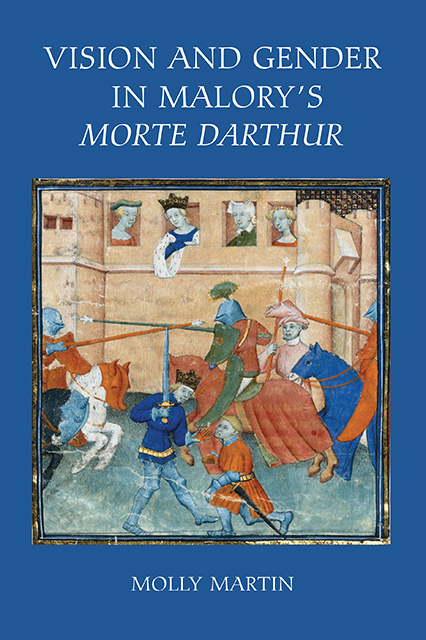Book contents
- Frontmatter
- Contents
- Acknowledgments
- Editorial Note
- Introduction: Masculinity and Vision in the Morte Darthur
- 1 “Beholdyng” Gareth: The Spectacle of Romance Masculinity
- 2 Gazing at the Queen: Trystram and Launcelot
- 3 Seeing Unseen: Palomydes and the Failure of Masculine Display
- 4 Romancing Religion: Competing Modes of Vision on the Grail Quest
- 5 The Female Gaze: Constructing Masculinity with and without Men
- Conclusion: Malory’s Arthurian Visions of Masculinity
- Bibliography
- Index
- Miscellaneous Endmatter
Introduction: Masculinity and Vision in the Morte Darthur
Published online by Cambridge University Press: 01 March 2023
- Frontmatter
- Contents
- Acknowledgments
- Editorial Note
- Introduction: Masculinity and Vision in the Morte Darthur
- 1 “Beholdyng” Gareth: The Spectacle of Romance Masculinity
- 2 Gazing at the Queen: Trystram and Launcelot
- 3 Seeing Unseen: Palomydes and the Failure of Masculine Display
- 4 Romancing Religion: Competing Modes of Vision on the Grail Quest
- 5 The Female Gaze: Constructing Masculinity with and without Men
- Conclusion: Malory’s Arthurian Visions of Masculinity
- Bibliography
- Index
- Miscellaneous Endmatter
Summary
This book dissects the crucial relationship between vision and gender in Sir Thomas Malory's Morte Darthur. I argue that defining and valorizing the male community of knights and its specific version of romance masculinity is a, if not the, primary concern in the Morte, and further, that the text foregrounds the role that visuality and especially visibility play in the negotiation of social and individual gender identities. In Malory's text, the necessary production of masculinity relies on the intricate workings of vision – both seeing and being seen – via intromissive, or inward, lines of sight, which move from the imaged body to the viewer's eye. Malory's attention to the direction of sightlines hints at their complicity in his masculinist project. At regular intervals, Malory emphasizes displays of gender, and particularly masculinity, by sharpening their visibility and focusing on those who see and react to male behaviors. Indeed, the text's interest in sightlines suggests that critical study of vision and its gender implications in Malory is overdue in this age of visual studies. This book, the first full-length study, attempts to fill that surprising critical gap.
The Morte's Arthurian community outlines rigid patterns of gender construction that are legislated through vision, in particular through a medieval understanding of intromissive sight. While traditional critical hierarchies of vision locate gender power with the male as the owner of the gaze, these medieval theories present a competing model that complicates visual relationships and ultimately makes them multidirectional.1 This forces a reconsideration of gender construction within the text's matrix of gazes. Interdisciplinary work on vision in the later Middle Ages reverses the direction of sightlines, and locates visual power primarily with the image. Consequently, masculinity primarily depends not on the projection of male vision, but rather on the projection of male images. Masculinity thus capitalizes on the production of visible displays of acts that are coded male by the society that defines it. Modern gaze theories are thus necessarily replaced – or at least supplemented – as a model for reading conjunctive moments of vision, gender, and genre in the Morte. The gaze's obtrusive and noticeably gendered impact on both its supposed subject, the viewer, and its object, the image, in so many romance visual exchanges – particularly the male captured by his look upon the female – forces closer inspection of the male's visual locus.
- Type
- Chapter
- Information
- Vision and Gender in Malory's Morte Darthur , pp. 1 - 24Publisher: Boydell & BrewerPrint publication year: 2010



